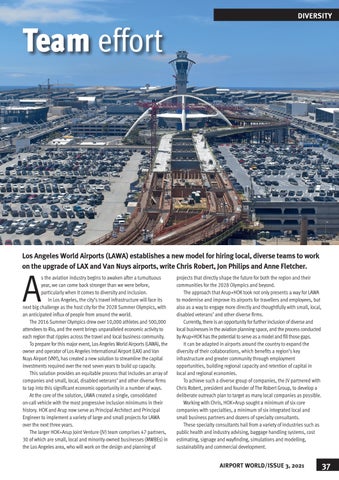DIVERSITY
Team effort
Los Angeles World Airports (LAWA) establishes a new model for hiring local, diverse teams to work on the upgrade of LAX and Van Nuys airports, write Chris Robert, Jon Philips and Anne Fletcher.
A
s the aviation industry begins to awaken after a tumultuous year, we can come back stronger than we were before, particularly when it comes to diversity and inclusion. In Los Angeles, the city’s travel infrastructure will face its next big challenge as the host city for the 2028 Summer Olympics, with an anticipated influx of people from around the world. The 2016 Summer Olympics drew over 10,000 athletes and 500,000 attendees to Rio, and the event brings unparalleled economic activity to each region that ripples across the travel and local business community. To prepare for this major event, Los Angeles World Airports (LAWA), the owner and operator of Los Angeles International Airport (LAX) and Van Nuys Airport (VNY), has created a new solution to streamline the capital investments required over the next seven years to build up capacity. This solution provides an equitable process that includes an array of companies and small, local, disabled veterans’ and other diverse firms to tap into this significant economic opportunity in a number of ways. At the core of the solution, LAWA created a single, consolidated on-call vehicle with the most progressive inclusion minimums in their history. HOK and Arup now serve as Principal Architect and Principal Engineer to implement a variety of large and small projects for LAWA over the next three years. The larger HOK+Arup Joint Venture (JV) team comprises 47 partners, 30 of which are small, local and minority-owned businesses (MWBEs) in the Los Angeles area, who will work on the design and planning of
projects that directly shape the future for both the region and their communities for the 2028 Olympics and beyond. The approach that Arup+HOK took not only presents a way for LAWA to modernise and improve its airports for travellers and employees, but also as a way to engage more directly and thoughtfully with small, local, disabled veterans’ and other diverse firms. Currently, there is an opportunity for further inclusion of diverse and local businesses in the aviation planning space, and the process conducted by Arup+HOK has the potential to serve as a model and fill those gaps. It can be adapted in airports around the country to expand the diversity of their collaborations, which benefits a region’s key infrastructure and greater community through employment opportunities, building regional capacity and retention of capital in local and regional economies. To achieve such a diverse group of companies, the JV partnered with Chris Robert, president and founder of The Robert Group, to develop a deliberate outreach plan to target as many local companies as possible. Working with Chris, HOK+Arup sought a minimum of six core companies with specialties, a minimum of six integrated local and small business partners and dozens of specialty consultants. These specialty consultants hail from a variety of industries such as public health and industry advising, baggage handling systems, cost estimating, signage and wayfinding, simulations and modelling, sustainability and commercial development.
AIRPORT WORLD/ISSUE 3, 2021
37















